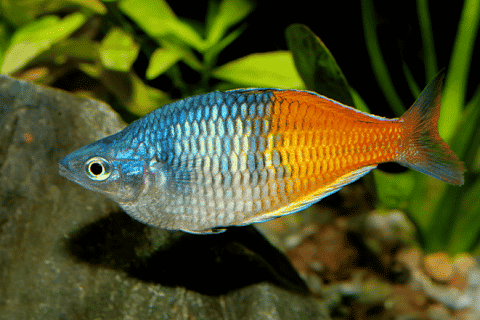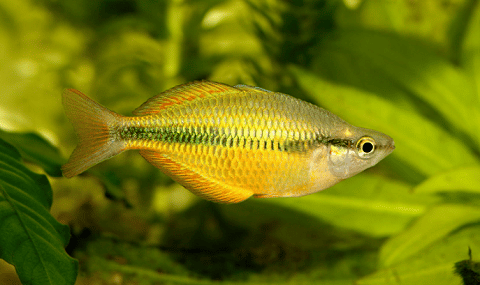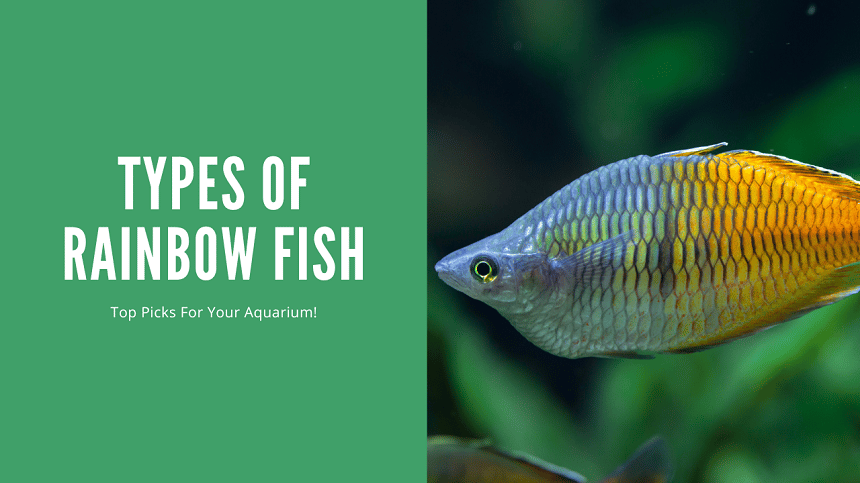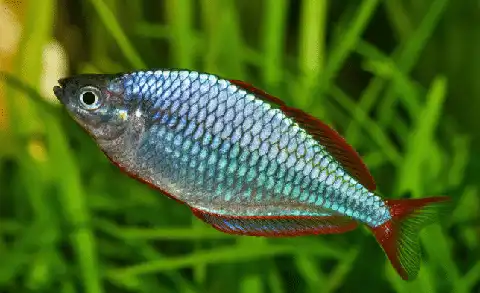Thank you for visiting! By the way… any links on this page that lead to products on Amazon and other stores/partners are affiliate links Aquarium Store Depot earns a commission if you make a purchase.
By bringing a rich diversity of colors to your freshwater community aquarium, Rainbow Fish know how to grab your attention and be the best companion to their community tank mates.
Rainbow fish are perfectly conflict-free, lively, and easy to handle. So, it doesn’t matter which stage of experience you are on as an aquarist, care for them can be totally undemanding.
But, do you know how many types of Rainbow Fish are out there and what are the care requirements of each? Don’t worry if you don’t!
In this article, I will walk you through a detailed guide that will definitely help you form a solid understanding of their dietary requirements, water conditions, and pretty much everything related to this peaceful fish.
An Overview of the Rainbow Fish
| Scientific Name | Melanotaenia Spp |
| Common Names | Rainbow Fish, Rainbowfish |
| Family | Melanotaeniidae |
| Origin | Indonesia, Eastern Australia, Northern Australia, North Carolina |
| Diet | Omnivore |
| Care Level | Easy to Moderate |
| Activity | Active |
| Lifespan | 5 to 8 years |
| Temperament | Peaceful |
| Tank Level | Top |
| Minimum Tank Size | 30 gallons |
| Temperature Range | 74° F to 80° F |
| Water Hardness | 10 to 20 KH |
| pH Range | 6.5 – 8.0 |
| Filtration/Water Flow | Moderate to Fast |
| Water Type | Freshwater |
| Breeding | Egg Layer |
| Difficulty to Breed | Easy |
| Compatibility | Community tanks |
| OK, for Planted Tanks? | Yes |
What is Rainbow Fish?
Rainbow Fish, scientifically known as Melanotaenia, is a part of the Melanotaeniidae family. They love to travel through moderate to strong water currents and prefer living in heavily planted aquariums.

Their peaceful temperament, coupled with their ability to get along with other freshwater fish species, makes them ideal for community tanks.
Experienced aquarists all around the world seek them out. And beginners who are reluctant to take a further step in their fish-keeping journey should definitely give this freshwater fish a try.
Origin and Habitat
Rainbow Fish are native to Australia and Indonesia. They were first sighted in 1903 by a British ichthyologist called Charles Regan Tata. Ever since their discovery, many ichthyologists from different parts of the world have been successful in bringing other Rainbow Fish species to notice.
Their natural habitats are scattered across different regions of Australia and Indonesia. Including the Raja Ampat Islands, Cendrawasih Bay, New Guinea, and other parts of Northern and Eastern Australia.
Because of originating from different international points, their water condition requirements don’t always match.
Appearance
In the aquarium trade, Rainbow Fish are popular because of their multi-colored bodies.
Their body coloring gives them a mesmerizing appearance. While they come in different shapes and sizes and have contrasting water conditions, they are pretty good at scaling up the beauty of your fish tank.
Some types of rainbowfish species stretch themselves up to 4.7 inches, while the other species of rainbowfish can go as big as 7.2 inches. Their body size generally depends on their type. So, you can’t really form an exclusive idea about their actual sizes.
Rainbow fish have large eyes and elongated premaxillary teeth. They have a pair of top fins, sitting at a little distance from each other, and a pelvic and anal fin. And in most types of rainbowfish, the anal fin appears red.
They have spiny dorsal, anal, and pelvic fins. These spines help them prevent falling prey to any mishap in the wild. The first of the dorsal fins has almost 6 spines on it, while the second has up to 22. And the anal spine comprises almost 30 spines.
You can see their pelvic fin attached to their rose-colored abdomens with a vulnerable sheet of skin that travels the length of their deep-seated ray.
As compared to an adult rainbow Fish, a juvenile rainbow fish has somewhat dim top fins. However, the coloration of the fins becomes vivid once it grows up.
The difference between a male and a female rainbow fish is the deepness of body coloring. The males are dazzling while the females come in duller body shades. Apart from this, females are plumper, while males are slender and have pointed fins.
15 Different Types
Here are some of the most famous rainbow fish types to consider adding to your community fish tanks. Check out the video below from our Official YouTube Channel for a visual treat. If you like our content, be sure to subscribe!
1. Threadfin
A stand-out rainbowfish. Small long bodies with long fins. They are one of the smallest Rainbowfish available
- Scientific Name: Iriatherina werneri
- Adult Size: 2 inches
- Color Pattern: Silver bodies with black and red spots on fins
- Unique Traits: Strands projecting from dorsal fins in males
Among other rainbowfish species, the Threadfin rainbowfish stand out pretty well. Their small-scale bodies with red tints on their fins add up to their uniqueness and aquarium beauty. They are the smallest species in their group you will ever come across.
To differentiate between a male Threadfin Rainbowfish and a female Threadfin Rainbowfish, look at their anal and dorsal fins. The males have filaments sticking out from their anal and dorsal fins, while the females completely lack them.
Pro Tip: Male Threadfin rainbowfish are prone to any fin-nipper fish. So, be really careful while choosing their tank mates.
2. Banded
- Scientific Name: Melanotaenia trifasciata
- Adult Size: 5 to 6 inches
- Color Pattern: Silver bodies with multi-colored stripes
- Unique Traits: Thick stripe running the length of the body
Familiar to the freshwaters of Northern Australia, Banded rainbowfish now dominate the community tanks with their captivating appearance (video from Imperial Tropicals).
Banded rainbowfish have wide body frames with a thick red/golden yellow stripe traveling lengthwise down their bodies. They are peaceful and love to swim through soft-moving waters.
3. Murray River

- Scientific Name: Melanotaenia fluviatilis
- Adult Size: 4 to 4.5 inches
- Color Pattern: silver-green bodies with a golden-brown outline
- Unique Traits: Silver bodies
Murray River rainbowfish, also known as Australian rainbowfish are native habitats of the rivers of South-eastern Australia. The beautiful color pattern of this Australian rainbow fish makes it mesmerizing and ideal for freshwater tanks.
The Australian rainbowfish has yellow fins which sometimes give reddish or orangish hues. The male fish has gleaming stripes on its back that look more prominent during the spawning season.
4. Boesemani

- Scientific Name: Melanotaenia boesemani
- Adult Size: 4 to 5 inches
- Color Pattern: Blue and golden yellow
- Unique Traits: Dual-colored body
With their two-toned wide bodies and deferential nature, The Boesemani rainbowfish is famous in the aquarium trade for the right reasons!
Boesemani rainbowfish are large and thrive in groups in big water tanks. Coming from the regions of Indonesia, the Boesemani rainbow fish prefers warm water temperatures and high pH levels.
5. Red Irian

- Scientific Name: Glossolepis incisus
- Adult Size: 6 inches
- Color Pattern: Red with yellow hues
- Unique Traits: Bright body color
Native to New Guinea, the Red Irian rainbowfish is now a favorite fish of aquarists. Their dietary requirements are the same as most tropical fish and they are quite relaxed around their tank mates.
The Red Irian rainbowfish is 6 inches in length, which makes it pretty big. The male fish look vibrant but loses its spark when the female is not around.
6. Desert
- Scientific Name: Melanotaenia splendida tatei
- Adult Size: 4 inches
- Color Pattern: Silver and white body with green tinted fins
- Unique Traits: Beautiful-pigmented fins
Desert rainbowfish are hard to find in the aquarium trade (video source). Even though they can easily adapt to different water conditions, desert rainbowfish don’t leave their freshwater habitats.
A desert rainbowfish comes in 3 different shades, ranging from silver to bluish-green. Usually, the females have silver-colored bodies with translucent fins. However, the male desert rainbowfish have purple-tinted fins and hues of cyan visible throughout their bodies.
7. Red
- Scientific Name: Glossolepis incises
- Adult Size: 6 inches
- Color Pattern: Red and brown
- Unique Traits: Red body
Red rainbowfish or Salmon Red rainbowfish (video source) originate from Indonesia and actively take part in increasing the beauty standard of aquariums around the world. They are beginner-friendlyand have trouble-free care needs overall.
While male Red rainbowfish are red, the females look brown and so do baby red rainbowfish.
Red Rainbowfish float in warm temperatures and can adjust themselves to changing water conditions.
8. Lake Tebera

- Scientific Name: Melanotaenia herbertaxelrodi
- Adult Size: 4 inches
- Color Pattern: Yellow body with a thick black band
- Unique Traits: Thick dark stripe
You can say that Lake Tebera rainbowfish and Lake Kutubo rainbowfish are townsfolk. Because both species are native to New Guinea.
Lake Tebera rainbowfish look bright yellow with a dark stripe that runs along the middle of their sides.
9. Celebes

- Scientific Name: Marosatherina ladigesi
- Adult Size: 3 inches
- Color Pattern: Transparent body with a yellow/dark/cobalt band
- Unique Traits: Projected strands
Celebes rainbowfish and Threadfine rainbowfish almost look alike. The Celebes rainbowfish has strands sticking out from the dorsal fins that look yellowish-golden.
10. Madagascar
- Scientific Name: Bedotia madagascariensis
- Adult Size: Around 6 inches
- Color Pattern: Silver bodies with flaxen-colored hues
- Unique Traits:
They got their name from their native hometown, which is Madagascar (video source). Madagascar rainbowfish have silver bodies mixed with pale yellow hues.
Madagascar rainbowfish are not good at tolerating shifting water conditions. They are used to soft water with low pH levels.
11. Lake Wanam
- Scientific Name: Glossolepis wanamensis
- Adult Size: 4 inches
- Color Pattern:
- Unique Traits: Long transparent dorsal fin
Lake Wanam rainbowfish look spectacular (video source). They have charming bodies, which are 4 inches in length. They can withstand slightly different water conditions. But drastic changes in water parameters can put their health in danger.
The male and female Lake Wanam rainbowfish own long and transparent dorsal fins. But you can’t really identify them due to weak information on the subject.
Though the waters of their native home haven’t changed, Lake Wana rainbowfish are virtually going extinct. And therefore, unlike with other fish, running across them is nearly impossible. They are critically endangered species, and maybe that is the reason we can’t find them too often in the aquarium trade.
12. Neon
A colorful rainbowfish that only grows up to 3 inches in length. Best in groups of 8 to 10
- Scientific Name: Melanotaenia praecox
- Adult Size: 2 to 2.5 inches
- Color Pattern: Shimmering blue with red/orange fins
- Unique Traits: Shimmery body coloring
The Neon rainbowfish or Dwarf Neon rainbowfish, is famous for its sparkling neon blue body color with red and orange fins. Their bodies are wide and they love big tanks to enjoy roaming around.
The easy way to identify a male and a female Neon rainbowfish is to look at their body size. The males have larger bodies while the females have slimmer. Another difference is their slightly contrasting fins. Male Neon rainbowfish have red fins, while the females have orange-tinted fins.
13. Lake Kutubu

- Scientific Name: Melanotaenia lacustris
- Adult Size: 5 inches
- Color Pattern: Cobalt blue, silver, turquoise colored bodies
- Unique Traits: Ability to change body color
Lake Kutubu rainbowfish can easily disguise themselves by changing their color. They are the natural inhabitants of Lake Kutubu in New Guinea.
Similar to other species of rainbowfish, the male lake Kutubu rainbowfish has vibrant body shades. They look dazzling blue and have yellow abdomens while the female fish have somber body coloring.
Compared to an adult Lake Kutubu rainbowfish, babies have slimmer bodies.
14. The Axelrod
- Scientific Name: Chilatherina axelrodi
- Adult Size: 4 inches
- Color pattern: Light blue and silver base color
- Unique Traits: Black stripes
The Axelrod Rainbowfish (video source), also known as Axelrodi rainbow fish, originates from Papua, New Guinea. This fish is named after the famous tropical fish expert Herbert Axelrod,
The Axelrod Rainbow fish prefer waters that are soft and fresh, resembling their hometown Yungkiri Stream of Papua New Guinea.
They have light silvery bodies, with the males having dark yellow spots on their fins. They also have various small-sized stripes scattered across their bodies.
15. Forktail

- Scientific Name: Pseudomugil furcatus
- Adult Size: 2.5 inches
- Color Pattern: Silver and yellow body with black stripes
- Unique Traits: Forked tail
The Forktail rainbow fish is another small freshwater tank fish that looks yellow. They are native to the river called Kwagira of Papua, New Guinea. They have blue eyes and silver-colored bodies, with the males displaying a bright yellow color while spawning.
Also, the females look paler and don’t have sharp dorsal and pectoral fins like the males. But they have yellow fins and outlined bottom and top bodies, giving them a unique characteristic.
Lifespan
The lifespan of rainbow fish varies. Some species live up to 8 years, while others can die as young as 3 in the wild.
Because of hailing from different Indonesian and Australian regions, keeping the fish healthy is important. Especially if they are placed with a different fish species. Some fish can tolerate deviations in water parameters. But the same water conditions can be nearly fatal for others.
The average water temperature ranges from 74° F to 80° F with pH levels between 6.5 to 8.0
Average Size
The average size of rainbow fish spans between 2 inches to 7.1 inches. You will find some fish sold at a very young age when their size is under-developing. They take at least 2 years to reach their full length.
Care
This amazing fish is ideal for non-professionals and pros. Replicating their native wild water conditions is also easy, given you have a solid basic understanding.
Almost all types of rainbow fish stay active and explore their surroundings. They are schooling fish and need to be put in a tank with at least 6-7 fish from their species.
Some fish prefer low pH levels, whereas others thrive in slightly high acidic waters. Therefore, before you carry out your plan of keeping them together, make sure they can coexist.
Aquarium Setup
Though some of these fish are good at tolerating shifting water parameters, others are sensitive to changes. To keep your fish healthy and away from stress, try mimicking their natural water conditions in your aquarium.
Almost all rainbowfish species thrive in freshwater. Some are accustomed to higher acidic levels, while some prefer lower pH conditioned waters.
In their native hometown, you can find dense plants surrounding them. These plants work as a shield and shade them.
Also, rainbowfish are surface feeders that spend most of their time exploring the surface. While feeding them, make sure the food doesn’t sink to the bottom of the tank.
To ensure their safety, keep a tight lid on the tank. Because they are large, energetic, stay on the surface, and can leap out of the tank pretty easily.
Tank Size
The minimum tank size is 30 gallons of water. Rainbow fish are schooling fish that need large swimming space to move around with their mates. 55 gallons and up would be preferable if you are looking to school a number of Rainbow fish.
If there are different species in the tank, you will need to add more water to your aquarium. So, it doesn’t really matter whether you own the smallest rainbowfish species or the largest ones, give them enough space to move.
Water Parameters
Right regulations of water are too important for most rainbowfish species to flourish. As said above, some fish of this species can easily withstand slightly different temperatures, pH levels, and water hardness. But a fish like Lake Wanam cannot.
Fish like Madagascar rainbow fish, Boesemani rainbowfish, and Red rainbow fish can adjust themselves to altered water conditions. So, if you are someone who slacks their work, go for these resilient fish.
Keep the water temperature between 74° F to 80° F, water hardness 10 to 20 KH, and pH levels 6.5 to 8.0.
Filtration and Aeration
Fish in groups produce a lot of waste that pollutes the water and damages the water quality. Therefore, installing a strong water filtration system is recommended.
To keep the water quality intact, you can go for the canister filtration system. Also, it should create strong currents to make the fish feel at home.
The Pro's Choice
The top choice among professional aquascapers. German engineering and equipped with an intregrated heater.
Lighting
Make your aquarium dimly lit and add lots of floating plants to it. Rainbowfish love shaded areas and floating plants can give them that.
To see them displaying their colors, you can use color-enhancing light bulbs.
Aquatic Plants And Decorations
A well-planted aquarium is ideal for your rainbowfish. In their natural habitats, the fish live in areas that have dense plants. These plants comfort them and are useful for the fish as a refuge. Introduce caves, thick vegetation, and other hiding spots all throughout the aquarium. Aquarium driftwood and aquascaping rocks are great choices for setting up a nature scape or natural setting.
For plants, you can try hardy plants like:
And don’t worry! These fish won’t ruin them.
Tank Maintenance
The best way to clean the tank is to keep changing the water up to 25%. Because low-quality water can damage the beauty of the tank. Always monitor your test levels with quality test kits.
Substrate
The dark substrate will bring out their beautiful coloration and unique patterns on the body. Even though you can use rocks that will work as hidden spots, avoid using jaggy rocks while making their substrate. For planted tanks, a planted tank substrate would be considered ideal for the benefit of your plants. You can top dress a substrate in decorative sand to build pathways.
Community Tankmates
Living in a school of at least 6 is one of their fundamental needs. They appreciate social gatherings and need to be put with their own kind.
You can house and care for different types of rainbowfish completely hassle-free, as long as the species are the same or similar in size. They don’t act aggressively. And because they are surface-feeding fish, they won’t trouble fish staying at the bottom of the tank.
Here’s a list of some most compatible tank mates for your rainbowfish.
- Plecos
- Tetras
- Angelfish
- Danios
- Corydoras catfish
- Barbs
- Platies
- Swordtails
- Mollies
- African Butterfly Fish
Poor Tank Mates
Breeding
Rainbowfish are egg layers and easy to breed. They don’t need separate breeding tanks, but a separate aquarium hobby is good for the safety of the fry.
Crossbreeding can result in discolored and diminutive fry. So, it’s better to form a pair of the same species.
Their breeding season starts once they are put on a protein-based diet, with gradual increases in water temperature. Near spawning, the males become vivid in coloration and speed up their swimming around the females. And some of them grow a prominent lateral stripe. And the females become plumper when they are ready to spawn.
Food and Diet
They go well with almost everything you put in their tank. You can feed them insect larvae, frozen foods, brine shrimp, mosquito larvae, and zooplankton.
You can also give them live foods such as glassworms, bloodworms, and daphnia only once or twice a day.
Pro tip: A rainbowfish takes 3 minutes to eat up its food. So, before feeding again, wait at least 3 minutes.
FAQs
Can I keep two together?
Have at least 6 of them together in your tank. 2 fish usually isn’t enough to fulfill their social needs. They enjoy the company of their own kind.
What kind of fish are they?
They are friendly, social, and freshwater fish species. Due to their size, they are best for medium to large-sized aquariums.
How fast do they grow?
They take at least 2 years to reach their full length. They generally are considered a moderate-growing fish.
Closing Thoughts
Rainbowfish are a great choice for any aquarium, but they really shine in larger tanks. These fish are colorful, social, and peaceful, making them a joy to watch. Have you kept rainbowfish before? Let us know your experience in the comments!
- About the Author
- Latest Posts
I’m thrilled that you found Aquarium Store Depot! Here you’ll find information on fish, aquariums, and all things aquatics related. I’m a hobbyist (being doing this since I was 11) and here to help other hobbyists thrive with their aquariums! I adhere to a high quality Editorial Process and Review products with real life field usage and practical analysis.








